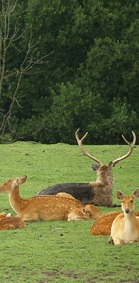 Animals in the Cervidae family are commonly called “Deer”.
Animals in the Cervidae family are commonly called “Deer”.
This family is wide spread, with species indigenous to most parts of the world (excluding Australia and Antarctica). Africa only contains one native species, Cervus elaphus barbarous, which is a subspecies of the red deer. They occur across a wide range of climates and ecosystems from the arctic to tropics, from forests to grasslands.
All species (except one) grow antlers. Antlers unlike horns of cattle, rhinos or other animals, are composed of bone, growing as an extension from the frontal bone in the skull. Antlers typically develop a branching growth.
Changes in the animal’s hormones will cause periodic decalcification of the antlers base (where it joins to the skull) causing it to shed (usually in late autumn or winter), after which the antler starts to regrow again. In most species only males have antlers. The reindeer (Rangifera tarandus) is an exception.
The social and reproductive behaviours can be more complex with Cervidae species. They are generally crepuscular, although they can be seen throughout the day. Most are polygynous, with the exception of the European Roe Deer who is monogamous. Socially they do differ between species and males may have a number of territories with herds of females. Some species live in harems, with one male guarding their herds of females, which can lead the guarding male to be challenged by stags. Males may also be travellers, going from one female herd to another, looking for females in oestrus. During mating season, rituals between males can be displayed, and it is usually the larger male who wins. Both males may be the same size and in their prime, and it is usually antler size which grants the dominance hierarchy. If both males are aggressive in nature, then a fight will usually break out. This is not in their best interests as will usually result in one of them being injured.
With all Cervidae’s the breeding season is relatively short, and depends on the location, habitat and area. The gestation period may be from 180 days to 240 days depending on the species, and the larger the species the longer the gestation. This is the same when nursing the young, smaller species will nurse young for around two to three months, larger species will be longer. They all tend to have litter size of one to three offspring.
Cervidae species in captivity tend to outlive their wild family members as they do not hold the risk of predators, or habitat loss.
Cervidae are all herbivores which eat a variety of grasses, shrubs and leaves. They are ruminants which means they are equipped with a four chambered stomach which allows for digestion of plant material. They will swallow food in to the first chamber to then regurgitate it as the cud.
There are at least 47 species (some authorities suggest more), though many are endangered, threatened or may be extinct. Living genera may include:
- Alces genus includes the Eurasian Elk and American Moose.
- Axis genera occur in Asia
- Blastocerus includes the Marsh Deer from occurs in Europe and Asia
- Capreolus genera occur in Europe and Asia
- Cervus includes the sika deer from Asia, and the more widely spread Elk
- Dama are species from Asia
- Elaphodus come from Asia
- Elaphurus has only one species which is extinct in the wild (indigenous to Asia)
- Hippocamelus is indigenous to South America
- Mazama (Brocket Deer) is a genus of 10 species mostly from South America
- Muntiacus is a genus of thirteen species, called “Muntjacs”, mostly from Asia.
- Odocoileus includes two species, both native to America
- Ozotocerus includes one species and a number of sub species from South America
- Przewalskium has one species (White Lipped Deer) from China
- Padu has two species, both from South America
- Rangifer (Caribou) may only include one living species but is an important species, widespread in the northern hemisphere.
- Rucervus includes two species from Asia
- Rusa includes four species from Asia
If you want to learn more about deer and other vertebrate animals; consider our vertebrate zoology course -click for details